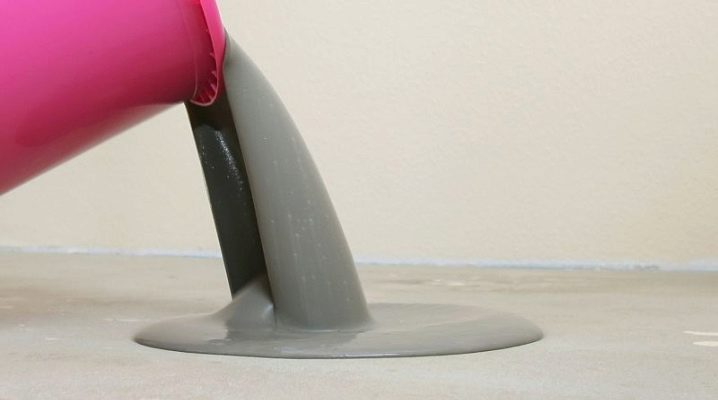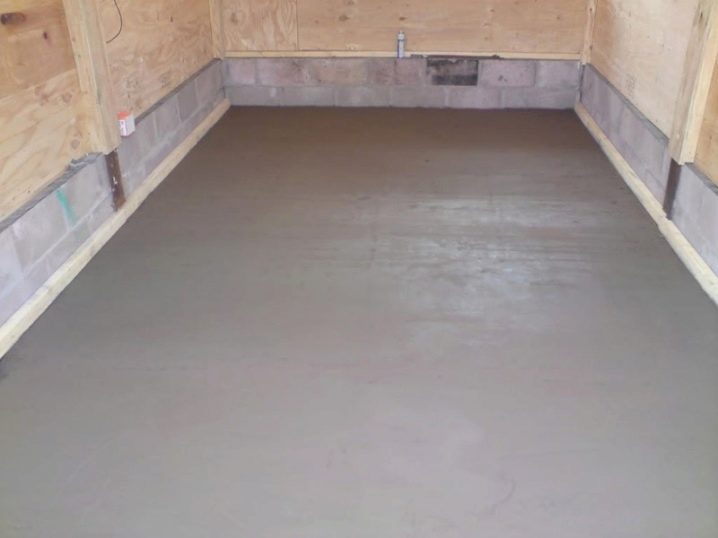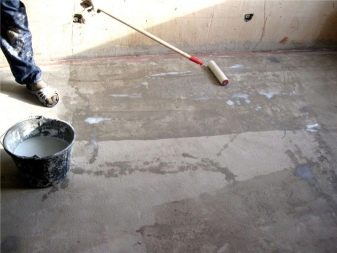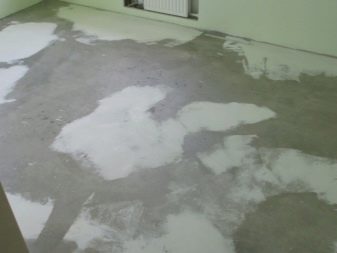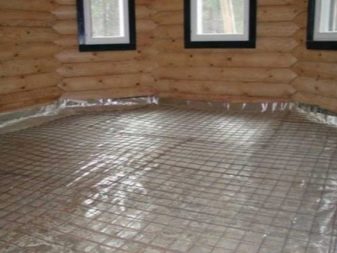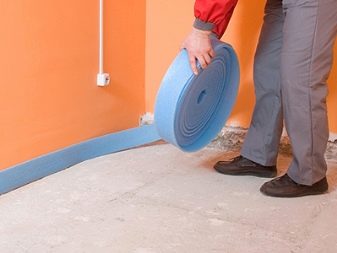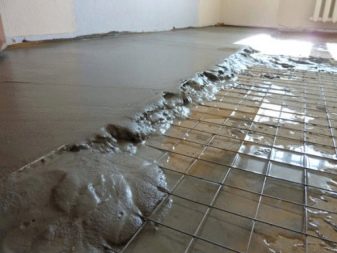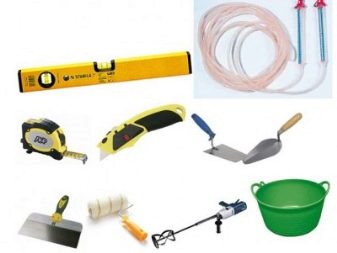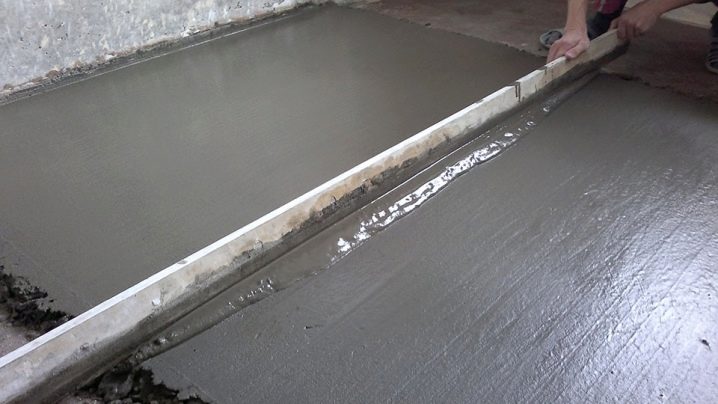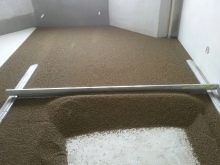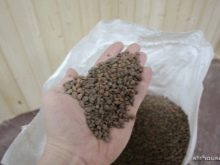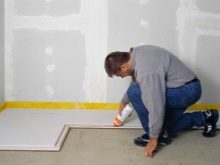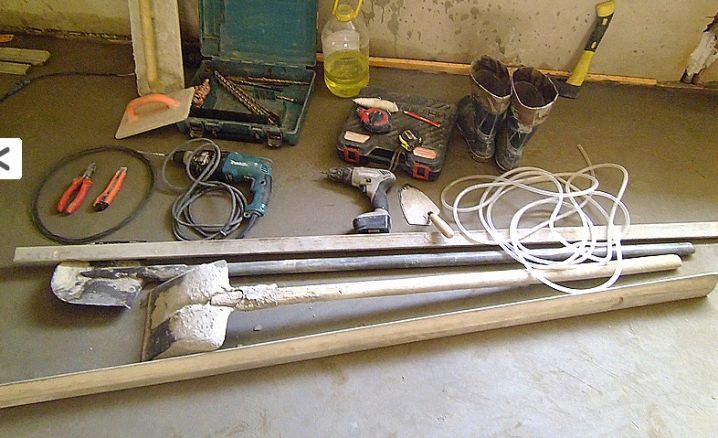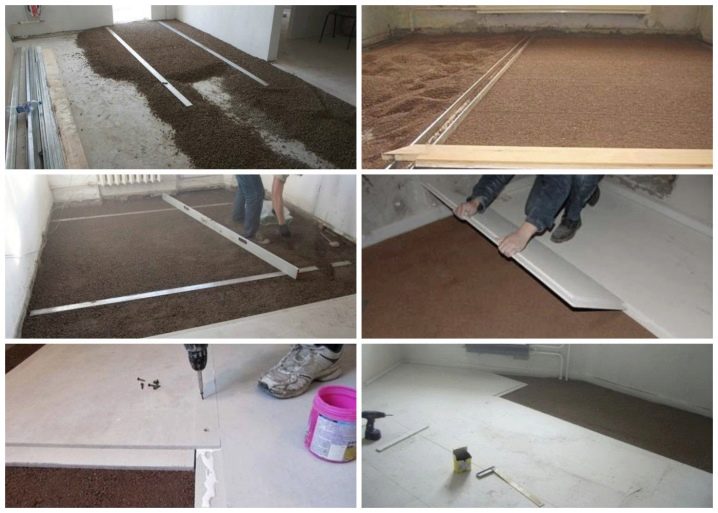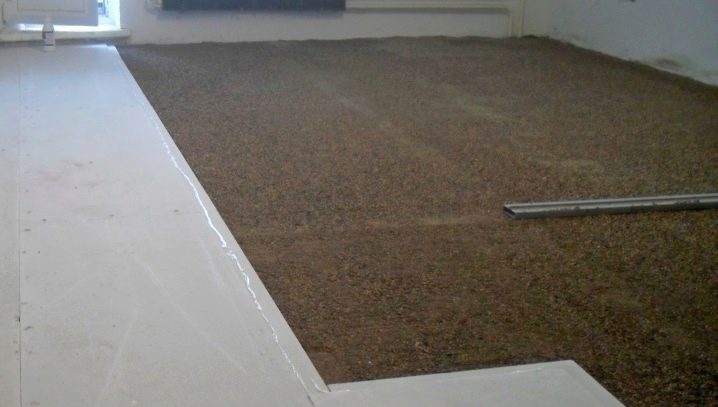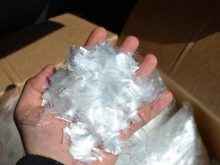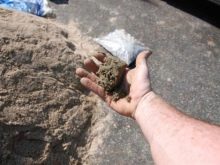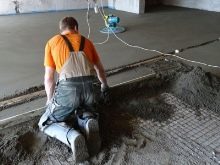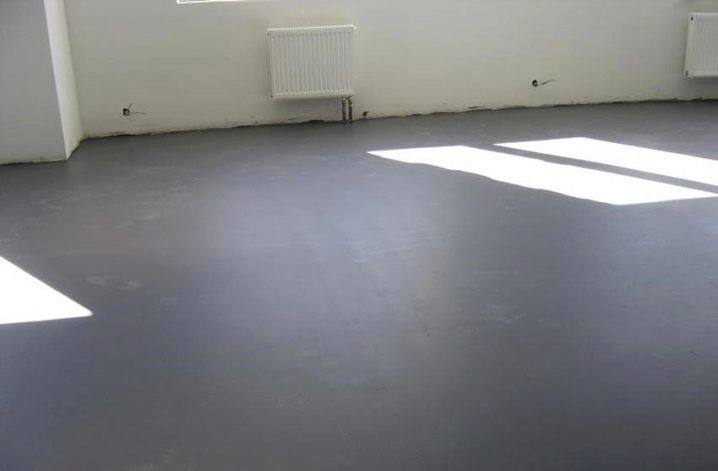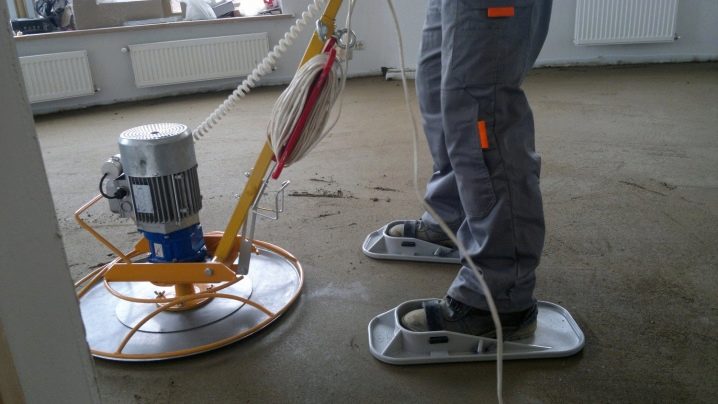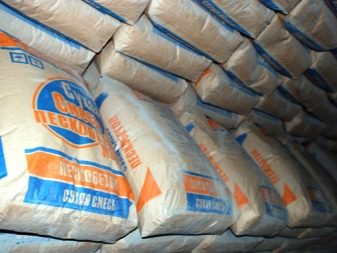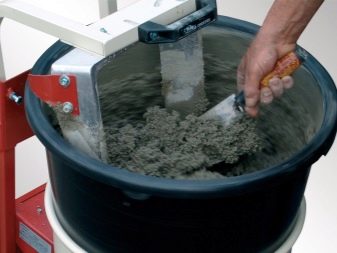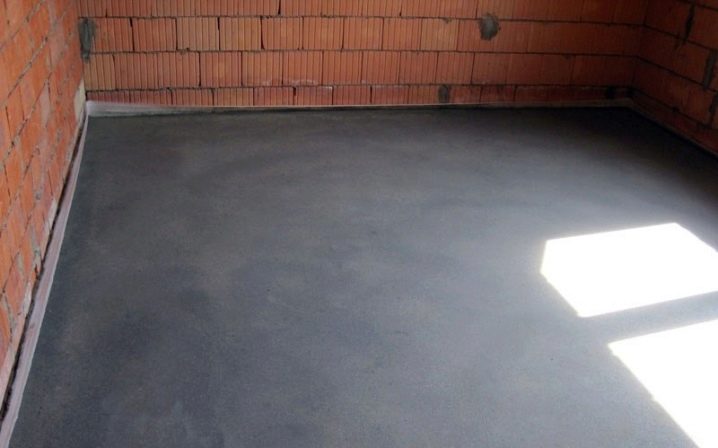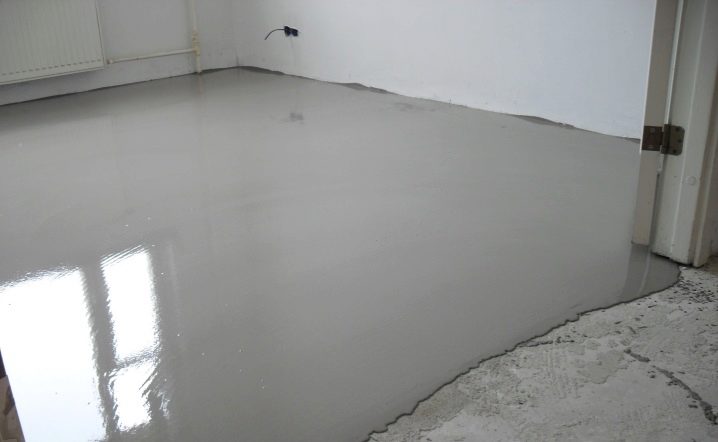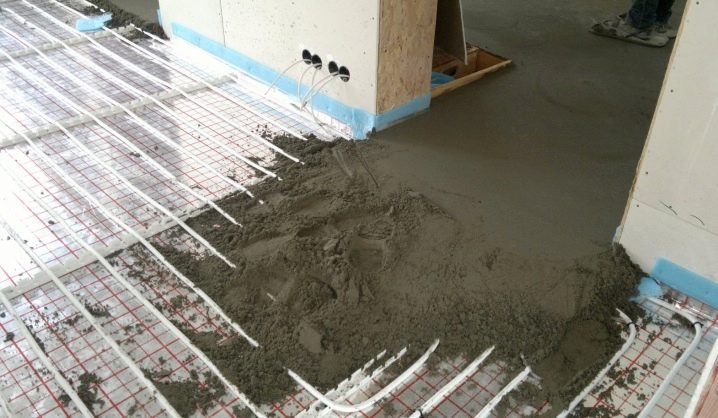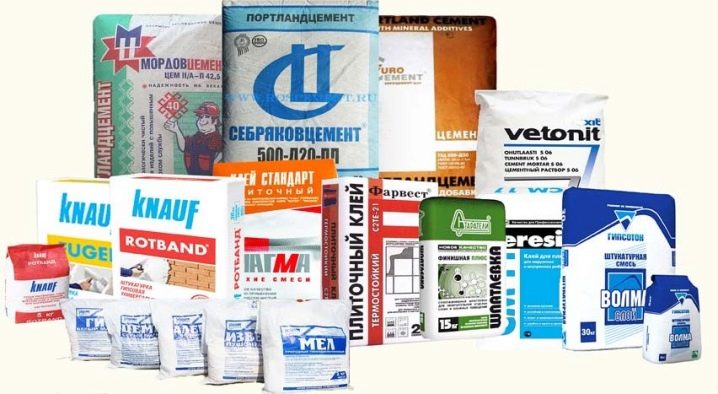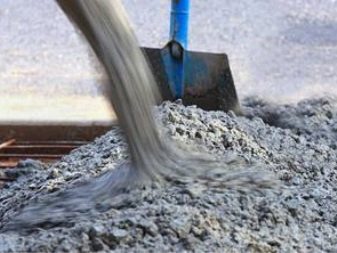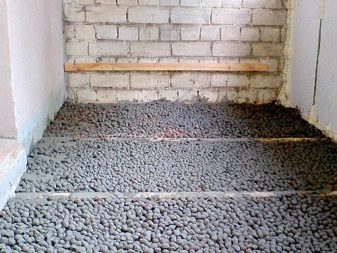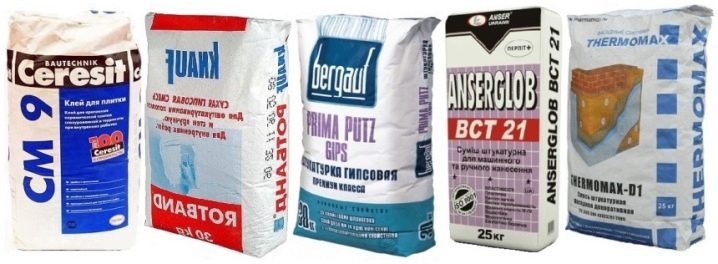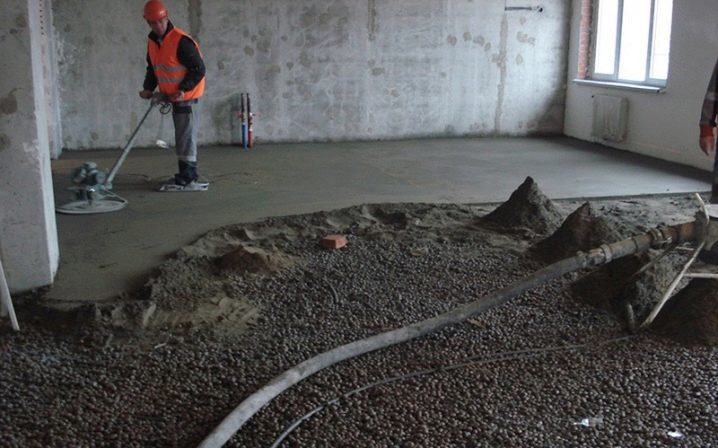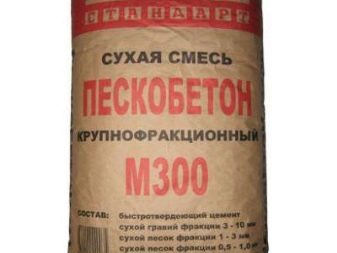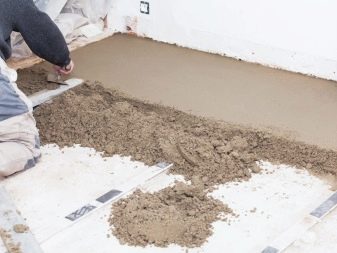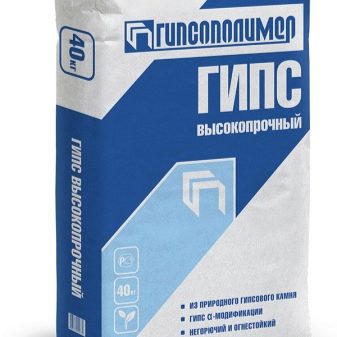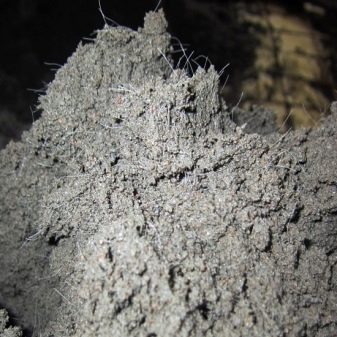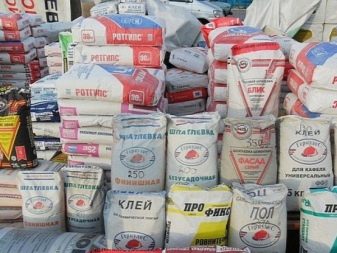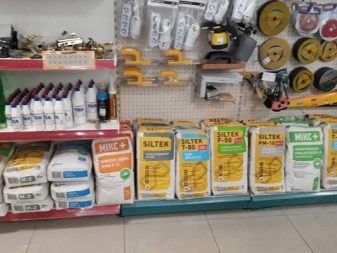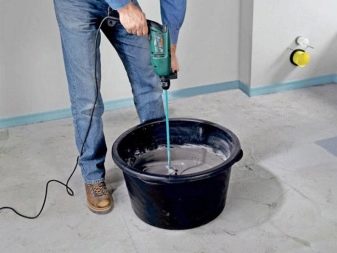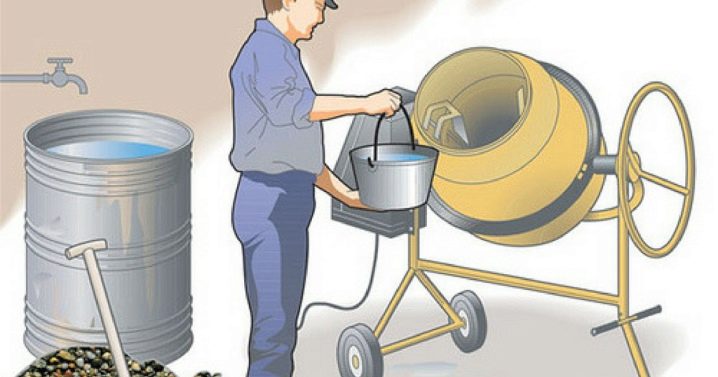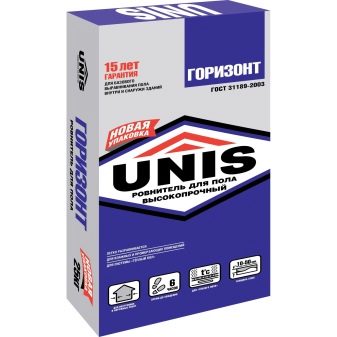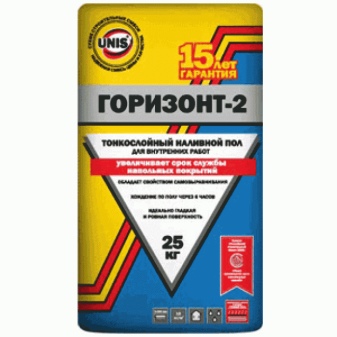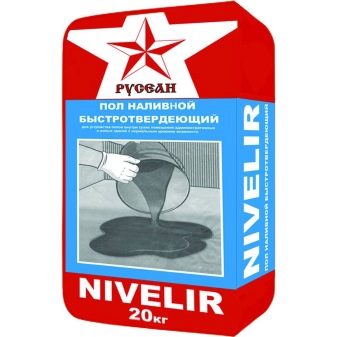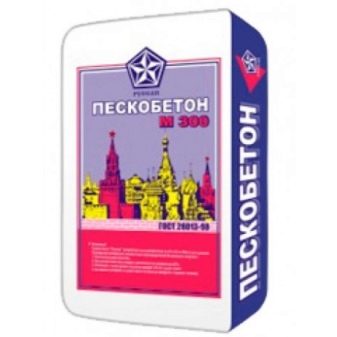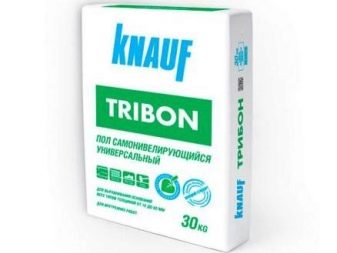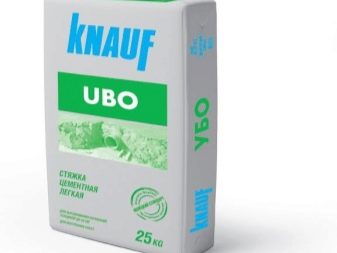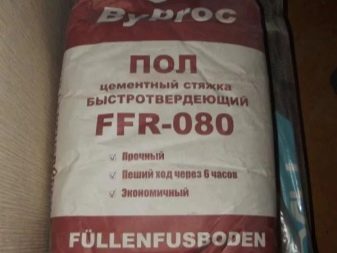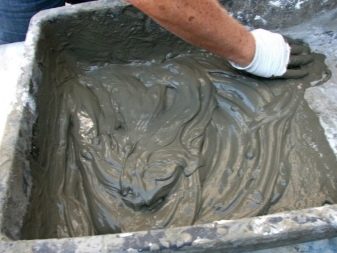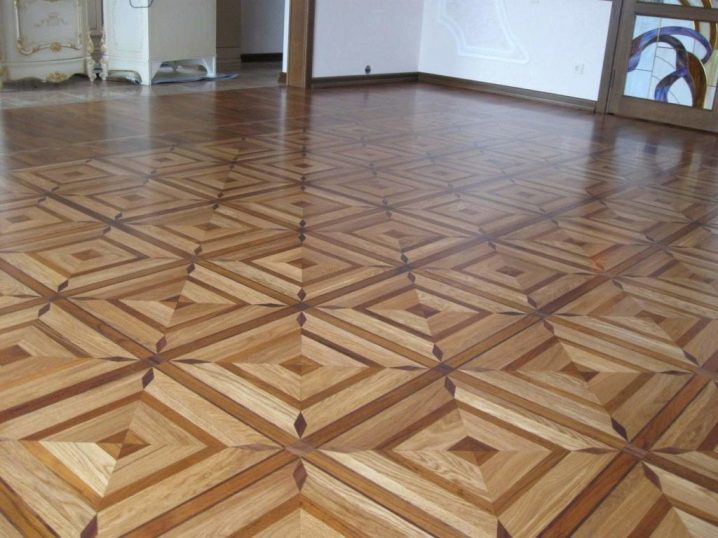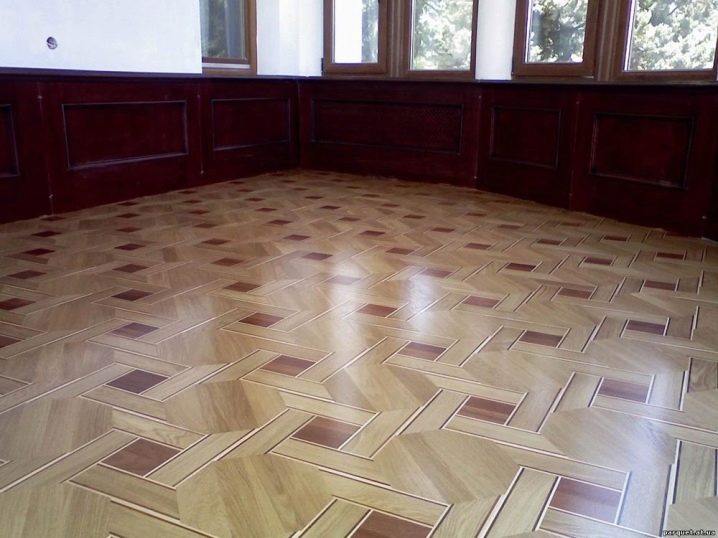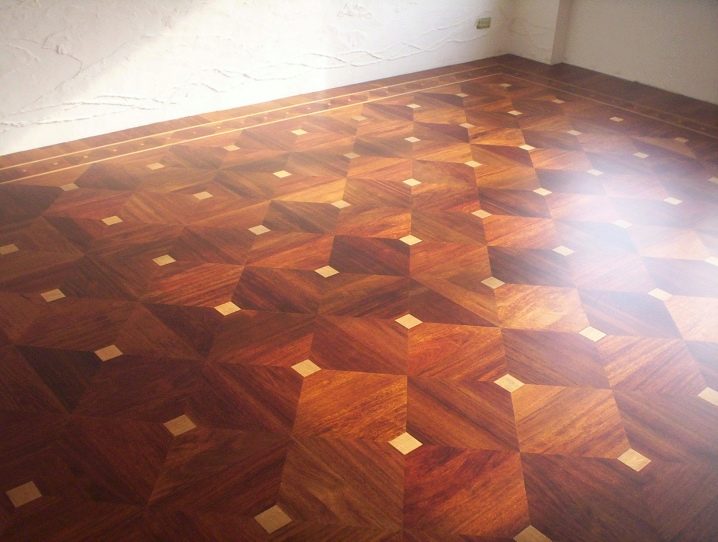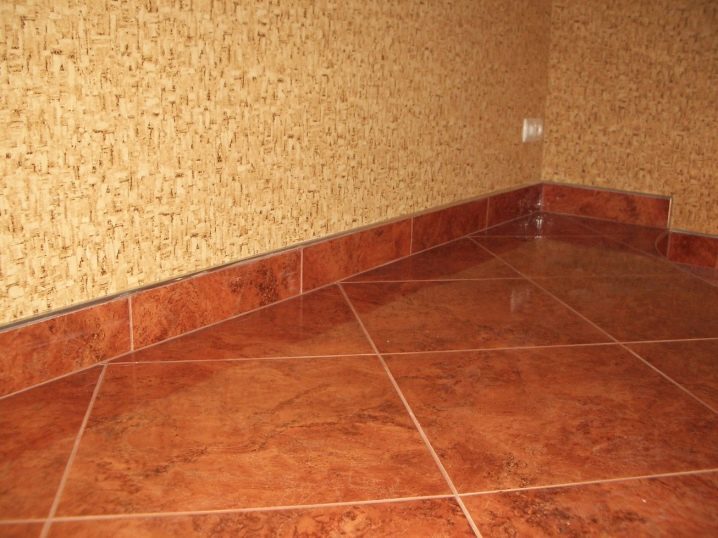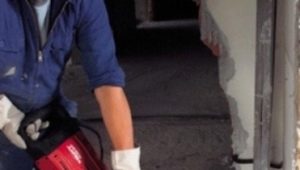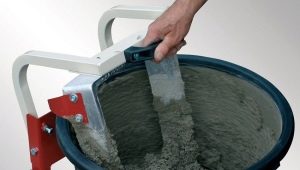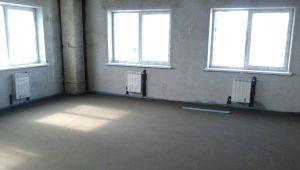Making a mixture for floor screed
The quality of the leveling of the floor surface depends on the cleanliness of the base, its preparation, the determination of floor height differences in the room and, of course, on the selected screed solution.
Special features
Its successful and long-term operation depends on the condition of the floor surface. You can achieve a good result in several ways. The screed process provides for three main types of work.
Wet fill
Despite the fact that the implementation requires a large amount of time, such a coupler is the most preferable option, since the quality of the solution used here is the highest. The duration is mainly influenced by the drying and “ripening” processes, and the working composition is sand concrete. Usually for work are required:
- primer;
- putty;
- waterproofing;
- damping tape to compensate for the deformation of concrete.
As the equipment used:
- metal beacons for alignment;
- special mixer;
- tank or concrete mixer;
- spatula or trowel;
- roulette;
- level.
The undoubted advantages are in the durability and affordable cost of the screed of this type. Among the minuses are:
- long drying period (about a month);
- the need for special equipment for mixing high-quality solution;
- in order for concrete to remain intact, reinforcement must be laid;
- in some cases, self-leveling mixture can not be applied.
In addition, in order to avoid seams, the whole process must be completed within 24 hours.
Dry screed
The process is quick because dry materials are used. You will need to prepare the following materials:
- waterproofing;
- primer;
- putty;
- metal profiles;
- plywood sheets;
- expanded clay;
- fasteners (screws);
- glue.
Besides, You will need the following tools:
- roulette;
- drill;
- level;
- lighthouses.
The main advantages of dry screed are:
- the possibility of self-assembly in the presence of experience;
- quickness: laying can be done after the glue applied to the seams has dried.
There are options for this and cons:
- exposure to moisture;
- high price;
- With illiterate backfilling, sagging of the upper sheets is possible. Sagging will cause the coating to crunch when used.
Semi-dry option
The peculiarity of this method is the use of special equipment: a trowel machine, a vibrator, a pneumatic pressure charger for pouring. You will also need a level and roulette. The following components are needed:
- mortar from sand, cement, fiberglass;
- waterproofing;
- damping tape.
"Maturation" depends on the applied coating and ranges from 4 to 25 days. The advantages of this type of work are as follows:
- high quality;
- resistance to mechanical stress;
- soundproofing;
- lack of reinforcing elements;
- maximum automation of the process.
The disadvantage of the semi-dry screed is the need to use special tools. It also requires sufficient experience in performing this kind of work. It should be noted that this type is considered the most suitable for repairing the floor in residential buildings and apartments.
Kinds
Compared with cement-sand mixtures and concrete, dry options are easier to prepare,and the process itself is not laborious. Some species are particularly effective for eliminating irregularities and significant drops. The main advantages are as follows:
- ease;
- small layer thickness with preservation of strength;
- minimum drying time;
- good leveling properties;
- possibility of application, even if there is no experience of carrying out such work;
- big choice.
Ready mixes are cement, plaster, for dry and semi-dry screed, universal for foundations or plastering.
- Sand cement it is used for the final alignment before the flooring of carpet, linoleum, can be used over heating systems, is used in street conditions. The usual thickness of the layer is from 40 to 80 mm, therefore, with significant differences in height, its use is inefficient.
- Self leveling contain a special filler. They spread well, and in some cases can be quick-drying. Self-leveling luxury mix is indispensable when laying laminate, parquet, ceramic tiles. Mixtures of this type are made on the basis of gypsum, fine sand and other chemical ingredients.Thanks to them, the life of any coating increases, and the maintenance and repair of floors is simplified.
An important condition is complete cleanliness of the base.
- Dry Options for a warm water floor contain plasticizers that eliminate the possibility of voids when pouring. They protect the surface from contact with air masses, because as a result of such contact the heating systems often do not work correctly or fail. Also for these purposes cement-sand mortar is used. In order to avoid condensate formation, it is cement that is used, not gypsum.
- Different types of construction products are used for puttying, priming, laying flooring, as well as thermal insulation and waterproofing. As a rule, this includes gypsum, cement, polymer compounds, lime and additional components to increase strength and moisture resistance. In addition, the elements are divided into concrete, mortar and dispersion, and differ in the size of grains. For mixing mixers are used cyclical or continuous type.
- Repair bases brick, concrete, limestone able to effectively level the floor.Most often they are waterproof, have good adhesion, but should be applied after thorough preparatory work. For concrete, special frost-resistant products are used, which, moreover, tolerate temperature drops well. They are necessary when there are cracks up to 0.3 mm, voids, chips and hollows, as well as corrosion.
- Ready plaster mixes applied to the base of wood or concrete. They are not afraid of exposure to water, steam. The advantage is their excellent adhesion, good leveling properties due to the fine structure. They are lighter than cement-sand mortars, durable, and can be used for independent work.
The main thing is to properly prepare the surface, and also apply a new layer only after the previous one has dried.
The finished products are suitable for both semi-dry and dry processes. Gypsum increases strength and hardens much faster than cement. In addition, a fines filler that does not create dust is often used. In order to apply this or that building material, it is important to know about the presence of certain components in it.
Composition
There are several highly demanded materials that are most often used for flooring. These include:
- Sand mixtureconsidered universal for leveling, plastering, finishing and other work processes. It includes Portland cement - sifted cement with the addition of minerals. His brand should not be below M500. Also sand mix contains sand (river or quarry) with fractional size not more than 1.5 mm. The main properties are water resistance, good adhesion, frost resistance, plasticity.
- Peskobetonnaya necessary for leveling the floor in any room. They should be moderately wet, and the mechanical loads on the base should not exceed the average values. In addition to sand, granite, hardener, plasticizers can be included in the mixture. Usually on the packaging itself you can find the characteristics of the composition: it is not susceptible to corrosion, resistant to cold, has high sound and heat insulation properties.
- Gypsum is a natural, environmentally friendly material, which is highly demanded. It hardens faster, absorbs liquid, and is well suited for laying parquet flooring, which does not shatter on the basis of such a fill.The main components are high-strength gypsum (alpha), fine sand from quartz, additives to improve plasticity and spreadability.
- For screed can be applied improved formulations supplemented with fiberglass or polypropylene additives that prevent cracking and desiccation of the surface. They are added to traditional sand and cement, reducing water permeability and increasing base strength. To create a warm floor is recommended to choose a mixture with a plasticizer SanPol in the composition.
Before you start self-pouring, you should take care of purchasing a product that will be optimal for a particular room.
How to choose?
When choosing, you should be guided by certain criteria:
- degree of adhesion. The higher it is, the stronger the base, more reliable flooring. In various options, it ranges from 0.5 to 1.5 MPa.
- Of great importance is the time of solidification, especially if the timing of the work is limited.
- You should pay attention to the duration of use of the finished solution. It usually ranges from 1 to 2 hours.
- When arranging the floor, the thickness of the permissible coating layer plays a role, since it is different for all mixtures.
- Advance is to make a calculation of the mixture consumption per 1 square. m
- It is important to consider the parameters of compressive and flexural strength. They directly affect the degree of wear.
To create a floor in the bathroom most often used cement-sand solution of high moisture resistance. Deciding to make a warm floor in the room, you can use self-leveling.
When it is planned to repair the floor in the apartment, it is best to use a finished dry screed. Although this option is more expensive, working with it is less time consuming than with the classic liquid cement-sand, which requires a long time to solidify. Fit and plaster. The mixer will be needed if building structures are used under a heated floor, and it is supposed to use heat and waterproofing. You can use a construction electric mixer or an ordinary drill that works at low revs (about 400-500 per minute).
Cooking your own hands
In order to save, it is possible to prepare the solution with your own hands. This mixture will be much cheaper than purchased. To do this, you must comply with the necessary proportions.
- You will need to thoroughly mix the cement brand M400 with quartz sand in a 1: 3 ratio.Water should be two times less than bulk solids. After its addition, the solution is mixed again so that its consistency is uniform. On 1 square. m will need about 20 kg of the finished viscous mass.
- To get a more durable base variant, it makes sense to combine 15 kg of cement, 40 kg of purified river sand, then slowly introduce 250 g of fiberglass. For plasticity, 0.6 l of plasticizer is diluted in 4 l of water, after which the mass is gradually introduced into the filling solution.
We must not forget about the thorough cleansing of the surface. From it you need to remove dirt, dust, then degrease, which will contribute to better adhesion. For degreasing, you can use dishwashing detergent.
Manufacturers
Carrying out repairs in your house or apartment, I want the finished mixture to fit perfectly in all respects. There are several brands whose products meet all stated quality requirements and are most popular among builders:
- "Horizon" - a basis for a floor from the Russian producer. Available in packs of 25 kg, designed for basic leveling layer of 10-50 mm. It is not recommended to flood the completed casting, or to allow the ingress of sunlight on it, as this contributes to premature drying.Specifications are as follows:
- compression strength: 200 kg per sq. cm;
- Coupling reliability: 2 kg per sq. cm;
- use time: 2 hours;
- frost resistance: at least 30 cycles;
- possibility of operation within 3-7 days.
- "Rusean" is a high-strength, economical product, affordable. The quality of the mixture is good. It is suitable for public and residential use. At temperatures below 20 degrees and low humidity, the solution increases its strength and sets faster. The mixture has several advantages:
- it is used for large height differences (up to 150 mm);
- possesses excellent strength characteristics;
- possesses maximum water resistance;
- frost-resistant;
- there is the possibility of mechanized and manual method of mixing;
- does not contain toxic substances hazardous to human health.
- Light mixture Knauf created on the basis of cement, polystyrene foam is used as a filler. It is used as a dry backfill, on top of which gypsum fiber is laid or poured bulk floors. The product is supplied in packs of 25 kg, the maximum allowable layer thickness is 300 mm.It is applied manually or with a special pump operating in continuous mode. The peculiarity is that the mixture for screed is suitable for a solid self-leveling floor. “Knauf” is a rather expensive material, which, however, fully justifies its cost.
All three brands are in demand, but you can determine which brand is better by reading reviews. There can be no a priori answer to this question a priori, since for someone it’s better that it’s cheaper, and not that which’s better. This approach is not entirely correct, because a low-grade version may be cheaper.
When buying a product, we must not forget that its quality is indicated by the characteristic gray color. Products of other shades are not worth buying. It does not hurt to ask and documentation, for example, a certificate.
Good examples
The most even base under the laminate can be achieved using a semi-dry screed using a self-leveling compound for finishing alignment Vetonit 3000. In this case, the thickness of the layer is only 15 mm, however, this absolutely does not affect the strength - hardening occurs after 4 hours.Laminate can be laid in a couple of days after. The screed "Vetonit 3000" is not afraid of exposure to water.
Lightweight mortar used for laying parquet. "Found the T-45 Scorline". Work carried out in one stage without special training. Concrete slab leveled to 100 mm. Due to the rapid hardening of the composition, such a floor is highly durable, not subject to the formation of cracks.
For the linoleum flooring used gypsum-fiber moisture resistant sheet Knauf. With it, produced dry screed and leveling. An additional advantage is the fire resistance of the floor.
Surface treated with self-leveling, quick-hardening mixture. "Foreman." Tiled flooring on this basis is ideally smooth, resistant to high humidity.
To repair or make the fill of the new floor easier and more convenient, using special dry mixes. Thanks to the information on the packaging, it is difficult to make a mistake in the proportions, and the instructions will help you correctly complete the installation.
To learn how to make a screed for pouring a warm floor at home, see the following video.
